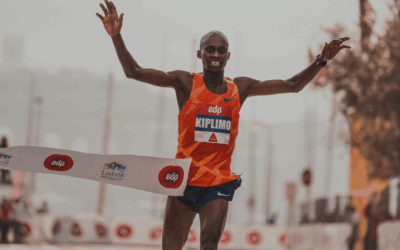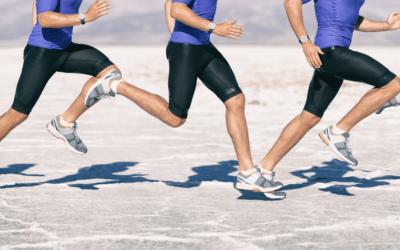Quick Navigation
- Foot Arch Pain: Intro
- Sinead’s Story of Overcoming Foot Arch Pain
- 7 Common Reasons for Foot Arch Pain
- Plantar Fasciitis
- Weak or Underused Foot Muscles
- Tight Calves or Ankle Stiffness
- Flat Feet
- High Arches
- Posterior Tibial Tendon Dysfunction (PTTD)
- Stress Fractures
- How to Relieve Foot Arch Pain
- Long-Term Fix for Foot Arch Pain
- Conclusion
- Author Bio
- References
Foot Arch Pain: A Common Problem for Runners
Foot arch pain from running can sideline even the most dedicated runners—but it doesn’t have to. Whether it’s plantar fasciitis, tight calves, or something more serious like a stress fracture, understanding the root cause is key.
In this post, we break down the most common reasons for arch pain and what actually works to fix them—based on real cases and current research.
If you’ve tried new shoes, rest, or orthotics without relief, this post is for you!
Sinead’s Story of Overcoming Foot Arch Pain
Our client Sinead transitioned from varsity hockey to distance running after retiring from sport. A few years in, she was running six days a week and planning her next race when foot arch pain began to creep in.
At first, she substituted one run a week for a bike ride. Eventually, running vanished from her schedule entirely, replaced with cycling – until even cycling began to aggravate her foot. It took years and multiple failed attempts at recovery through physio, running clinics, new shoes, and orthotics before she was referred to us.
After working together, she left this review:
“I do hope you understand the magnitude of my appreciation to your clinic and efforts. It took 3 years and so many attempts with physio/running clinics/running shoes etc. and you got me to the point where I can now run 4 days a week issue-free.”
So how did we get there?
7 Common Reasons for Foot Arch Pain
Let’s unpack the causes, fixes, and long-term solutions to foot arch pain in runners—so you don’t have to wait 3 years to feel better.
1. Plantar Fasciitis
Plantar fasciitis is the most common cause of arch pain in runners. It presents as sharp, localized pain near the heel, often worse during the first steps in the morning or after prolonged sitting (Thompson et al., 2014). Though commonly labeled an inflammatory condition, research shows it is primarily degenerative in nature (Wearing et al., 2006).
Risk factors include increased mileage, poor footwear, tight calves, and biomechanical overload. We will come back to this later, but we want you to remember that overload means more load than your structure can handle (and hint hint, getting more load-capacity through strength training can help).
2. Weak or Underused Foot Muscles
Many runners rely on their shoes for support but never actually train the muscles that should be doing the work. Over time, the small muscles that help maintain the foot’s shape and absorb force get lazy. As a result, the larger structures – like the plantar fascia or posterior tibial tendon – take on more load than they’re designed for (or than they are currently strong enough for), leading to fatigue, poor push-off mechanics, and increased strain on the arch during longer runs or hills.
What’s tricky is this kind of weakness doesn’t always show up in day-to-day activities. It often hides until mileage climbs or terrain changes. A quick test like the “short foot exercise” or observing single-leg balance on an unstable surface can reveal deficits. Rebuilding intrinsic strength doesn’t happen overnight, but with consistent loading through things like toe dissociation, arch winding exercises, and barefoot drills, runners can dramatically improve their arch resilience.
3. Tight Calves and Ankle Stiffness
Limited ankle dorsiflexion – often due to tight gastrocnemius or soleus muscles (that collectively make up the calf muscles) can shift the workload to the plantar fascia and midfoot. One study found gastrocnemius tightness in 76.6% of individuals with flat feet, especially in women (Mohamed et al., 2022). A lack of ankle mobility creates compensations that strain the arch.
Clinically, runners with ankle stiffness may also report heel pain, shin splints, or even knee issues – because they’re not absorbing load effectively with each step. A simple wall lunge test or heel drop assessment can often reveal mobility limitations. Stretching, eccentric calf training, and joint mobilizations (either self-directed or with a therapist) are critical in restoring the natural shock-absorbing sequence of the lower limb.
4. Flat Feet
Also known as pes planus, this condition involves a collapsed medial arch and excessive pronation. Not all flat feet are painful, but when they are, issues like plantar fasciitis, tibialis posterior dysfunction, and Achilles overload are common (Herchenröder et al., 2021). While orthotics are commonly prescribed, evidence supporting their long-term benefit is limited and mixed.
A low arch in static standing isn’t always a problem – but a collapsing arch during movement usually is. In dynamic activity, an uncontrolled flattening of the arch can overstress the plantar fascia, posterior tibial tendon, and midfoot joints. For runners, this might show up as arch fatigue on long runs, pain at the navicular bone, or medial shin soreness.
5. High Arches
High arches may look ideal, but they’re often biomechanically problematic. High arches (pes cavus) are more rigid and less capable of shock absorption. As a result, runners with this foot type may experience concentrated pressure in the midfoot or metatarsals, leading to pain or stress fractures (Paavana et al., 2024).
Because the foot doesn’t “spread” well during stance, runners with high arches may benefit from shoes with more cushion and a wider base of support. They also might further benefit from pronation drills, more perroneal strengthening, and drills to control the arch into a pronated and stretched position.
6. Posterior Tibial Tendon Dysfunction (PTTD)
The posterior tibial tendon plays a key role in arch support. When it begins to degenerate, symptoms often start as subtle medial foot or ankle pain, progressing to a visible flattening of the arch and instability with walking or running (Rhim et al., 2022). This condition is particularly common in active women over 40 and often goes underdiagnosed.
Over time, this can shift foot structure, affect gait mechanics, and even cause compensation injuries at the knee or hip. Early signs include pain during heel raises, difficulty with balance, or medial arch pain that worsens with prolonged standing or walking. We wrote a whole blog on tendons.. And if you’re interested in heading down a tendon rabbit hole head here: 16 Key Things You Need To Know About Tendons.
7. Stress Fractures
If your pain feels deep, pinpoint, and worsens with loading but doesn’t go away with rest, a stress fracture may be at play. These overuse injuries are most common in the metatarsals and navicular bones—especially in female runners with low energy availability or vitamin D deficiency (Kale et al., 2022; Knechtle et al., 2021).
Bone stress injuries in the foot are common in the navicular and metatarsals, especially in runners with low energy availability, poor recovery habits, or sudden training spikes. Diagnosis often requires imaging, and treatment involves deloading followed by a gradual return-to-run plan that emphasizes capacity building and bone health support.
How to Relieve Foot Arch Pain
Pain relief starts with identifying the root cause—mobility, strength, or structure:
A. If It’s a Mobility Issue
When ankle or toe stiffness limits foot function, your foot may be overcompensating elsewhere. Self-mobilization with lacrosse ball releases, slant board stretches, and targeted calf stretches can help (Chinn & Hertel, 2010).
B. If It’s a Strength Issue
Addressing intrinsic foot weakness and proximal control can reduce arch overload. Exercises like short foot, towel scrunches, toe dissociations, and dynamic balance work are all part of our 12-week Foot Foundations program. (Use code FOOTARCH for 10% off).
C. If It’s Structural or Suspected to Be a Bone Injury
Structural deformities or stress injuries should be ruled out by a physical therapist, sports medicine physician, or orthopaedic specialist. Conditions like PTTD or stress fractures benefit from temporary unloading, medical imaging, and a more gradual return-to-run strategy with the guidance of a professional.
D. When to Get an Assessment
If you’re unsure what’s causing your arch pain or it’s not improving with rest and basic strengthening, it’s time for an assessment. A therapist or coach with expertise in running gait, foot function, and loading mechanics can save you years of trial and error.
Long-Term Fix for Foot Arch Pain
Every condition listed above shares one root theme: load intolerance. Something in your system – whether it’s a tendon, fascia, bone, or muscle – is being asked to tolerate more stress than it can currently handle.
The long-term fix is to rebuild that capacity to prevent arch pain.
That’s exactly what we did with Sinead. By slowly reloading her foot with the right mobility work, strength progression, and run re-integration plan, she got back to the activity she loves – running.
Our Foot Foundations program was designed with this exact need in mind. It includes:
- 3 strength days per week
- 1 mobility/recovery day
- Progressive loading, tailored to foot type
- Self-assessment and education tools
If you’re struggling with foot arch pain, there’s a way forward. Don’t let it steal years of your running journey.
Conclusion
“It’s not just about the foot – it’s about how you train it.”
Whether your issue stems from mobility, strength, or structural challenges, foot pain is fixable when approached with the right plan. If you’re unsure where to start, reach out to our team or try the Foot Foundations program (use code FOOTARCH for 10% off).
We’d love to help you write your own version of Sinead’s story.
References
Chinn, L., & Hertel, J. (2010). Rehabilitation of ankle and foot injuries in athletes. Clinics in Sports Medicine, 29(1), 157–167. https://doi.org/10.1016/j.csm.2009.09.006
Herchenröder, M., Wilfling, D., & Steinhäuser, J. (2021). Evidence for foot orthoses for adults with flatfoot: A systematic review. Journal of Foot and Ankle Research, 14(1), 57. https://doi.org/10.1186/s13047-021-00499-z
Kale, N. N., Wang, C. X., Wu, V. J., Miskimin, C., & Mulcahey, M. K. (2022). Age and female sex are important risk factors for stress fractures: A nationwide database analysis. Sports Health, 14(6), 805–812. https://doi.org/10.1177/19417381221080440
Knechtle, B., Jastrzębski, Z., Hill, L., & Nikolaidis, P. T. (2021). Vitamin D and stress fractures in sport: Preventive and therapeutic measures—A narrative review. Medicina, 57(3), 223. https://doi.org/10.3390/medicina57030223
Mohamed, S. H. K., Youssef, E. F., Faggal, M. S., & Ibrahim, M. M. (2022). Prevalence of calf muscle tightness in asymptomatic flat foot subjects. Egyptian Journal of Physical Therapy, 10, 26–31.
Paavana, T., Rammohan, R., & Hariharan, K. (2024). Stress fractures of the foot—Current evidence on management. Journal of Clinical Orthopaedics and Trauma, 50, 102381. https://doi.org/10.1016/j.jcot.2024.102381
Rhim, H. C., Dhawan, R., Gureck, A. E., Lieberman, D. E., Nolan, D. C., Elshafey, R., & Tenforde, A. S. (2022). Characteristics and future direction of tibialis posterior tendinopathy research: A scoping review. Medicina, 58(12), 1858. https://doi.org/10.3390/medicina58121858
Smith, J. T., Halim, K., Palms, D. A., Okike, K., Bluman, E. M., & Chiodo, C. P. (2014). Prevalence of vitamin D deficiency in patients with foot and ankle injuries. Foot & Ankle International, 35(1), 8–13. https://doi.org/10.1177/1071100713509240
Thompson, J. V., Saini, S. S., Reb, C. W., & Daniel, J. N. (2014). Diagnosis and management of plantar fasciitis. The Journal of the American Osteopathic Association, 114(12), 900–906. https://doi.org/10.7556/jaoa.2014.177
Wearing, S. C., Smeathers, J. E., Urry, S. R., Hennig, E. M., & Hills, A. P. (2006). The pathomechanics of plantar fasciitis. Sports Medicine, 36(7), 585–611. https://doi.org/10.2165/00007256-200636070-00004
Quick Navigation
- Foot Arch Pain: Intro
- Sinead’s Story of Overcoming Foot Arch Pain
- 7 Common Reasons for Foot Arch Pain
- Plantar Fasciitis
- Weak or Underused Foot Muscles
- Tight Calves or Ankle Stiffness
- Flat Feet
- High Arches
- Posterior Tibial Tendon Dysfunction (PTTD)
- Stress Fractures
- How to Relieve Foot Arch Pain
- Long-Term Fix for Foot Arch Pain
- Conclusion
- Author Bio
- References




